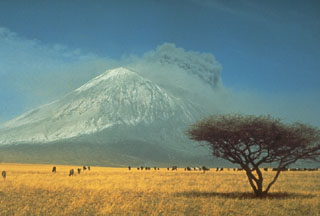Report on Ol Doinyo Lengai (Tanzania) — 24 October-30 October 2007
Smithsonian Institution / US Geological Survey
Weekly Volcanic Activity Report, 24 October-30 October 2007
Managing Editor: Sally Sennert.
Please cite this report as:
Global Volcanism Program, 2007. Report on Ol Doinyo Lengai (Tanzania) (Sennert, S, ed.). Weekly Volcanic Activity Report, 24 October-30 October 2007. Smithsonian Institution and US Geological Survey.
Ol Doinyo Lengai
Tanzania
2.764°S, 35.914°E; summit elev. 2962 m
All times are local (unless otherwise noted)
Based on pilot observations, the Toulouse VAAC reported that ash plumes from Ol Doinyo Lengai rose to altitudes of 3.2-4.6 km (10,500-15,000 ft) a.s.l. on 23 October. According to Frederick Belton's Ol Doinyo Lengai website, a pilot photographed an ash column rising vertically from the summit on approximately 25 October.
Geological Summary. The symmetrical Ol Doinyo Lengai is the only volcano known to have erupted carbonatite tephras and lavas in historical time. The prominent stratovolcano, known to the Maasai as "The Mountain of God," rises abruptly above the broad plain south of Lake Natron in the Gregory Rift Valley. The cone-building stage ended about 15,000 years ago and was followed by periodic ejection of natrocarbonatitic and nephelinite tephra during the Holocene. Historical eruptions have consisted of smaller tephra ejections and emission of numerous natrocarbonatitic lava flows on the floor of the summit crater and occasionally down the upper flanks. The depth and morphology of the northern crater have changed dramatically during the course of historical eruptions, ranging from steep crater walls about 200 m deep in the mid-20th century to shallow platforms mostly filling the crater. Long-term lava effusion in the summit crater beginning in 1983 had by the turn of the century mostly filled the northern crater; by late 1998 lava had begun overflowing the crater rim.
Sources: Toulouse Volcanic Ash Advisory Centre (VAAC), Ol Doinyo Lengai (Fred Belton)

